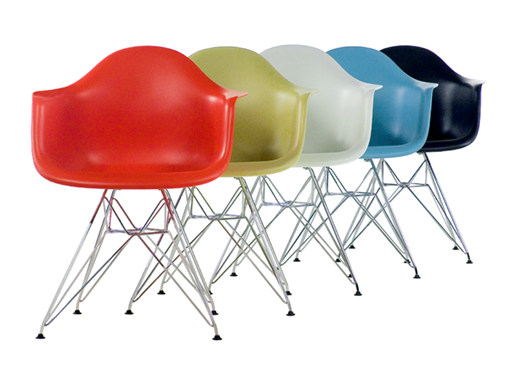Design Classics
Moulded Chair, 1948
Designer: Charles and Ray Eames
Manufacturer: Herman Miller

Charles Eames and his wife and partner, Ray, were two of the most influential American designers of the 20th-century. From his humble beginning as a steel-mill worker, Charles went on to study and teach at Cranbook Academy of Art in Bloomfield Hills, Mich. In 1941, the Eameses moved to Venice, Calif., where their studio produced furniture, films, toys, books and architecture, as well as a cadre of designers, many of whom went on to become prominent in their own right. Charles Eames once said that the primary condition of the practice of design was “the recognition of need” and he compared a designer or architect to a good host – anticipating the needs of his guests. The hundreds of designs that flowed from the Eames studio reflect this focus on designs that work by combining humanity, humour and beauty.
WHAT
Like many designers of the 20th-century, the Eameses were fascinated by the possibilities of mass production. When the Museum of Modern Art sponsored an International Competition for Low-Cost Furniture Design in 1948, the Eameses saw an opportunity to get “the most of the best to the greatest number of people for the least.” Collaborating with a team of engineers from UCLA, they developed a prototype of moulded chair in steel. It had the right form, but was heavy and expensive to produce. Undaunted, Eames turned to fibreglas, a material he had seen used during the war. He found a fabricator of boat and car prototypes who agreed to take on the challenge. The resulting fibreglass moulded shell was perfect for new production technology and, by attaching it by means of rubber shock absorbers to a variety of bases, the dream of a low coast, high quality and endlessly variable mass-market chair was realized. There was only one problem: the fibreglass-reinforced plastic was too durable and dangerous to work with. Due to these concerns, the manufacturer, Herman Miller, took the chair out of production in the early 1990s. In 2000, Herman Miller reintroduced the chairs made from polypropylene – a recyclable plastic that could also reproduce the intense colours of the original production.
WHY
Surprisingly for a designer, Eames was not interested in “good design.” In fact, design historian David Ostroff writes that Eames would often scoff at the pretension with: “Don't give us that good design crap. The real questions are: Does it solve a problem? Is it serviceable? How is it going to look in 10 years?” By any standards, the Eames moulded chairs answer in the affirmative to these questions and represent the true Eames legacy – “problems beautifully solved.”
National Post, June 1, 2006.
